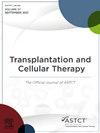来替莫韦对高风险异基因造血细胞移植(HCT)受者复发 CMV 的预防。
IF 3.6
3区 医学
Q2 HEMATOLOGY
引用次数: 0
摘要
背景:我们评估了利特莫韦(LTV)在巨细胞病毒(CMV)复发高风险的异基因造血细胞移植(HCT)患者中对巨细胞病毒(CMV)的二级预防作用。方法:在纪念斯隆凯特琳癌症中心和明尼苏达大学进行的开放标签研究。临床显著的巨细胞病毒感染(cs-CMVi)和≥1高危标准的巨细胞病毒患者,使用标准的巨细胞病毒抗病毒药物实现病毒抑制,接受利特莫韦(LTV)二级预防治疗长达14周。主要终点是第14周时的cs-CMVi。次要终点包括:第14周时,LTV耐药性、CMV终末器官疾病(EOD)、CMV相关死亡和LTV相关不良事件(AE)。结果:共分析36例患者(CMV血清阳性33例,t细胞缺失HCT 25例,脐带血移植5例)。到第14周,5例患者达到了cs-CMVi的主要终点,累积发病率为14.9%(95%可信区间为2.6 - 27.1)。4例患者出现LTV突破性cs-CMVi(其中2例确诊为LTV耐药)。其余患者因参加临床试验而过早停止LTV后出现反弹cs-CMVI。到第14周或第24周,没有CMV EOD或CMV相关死亡或LTV相关AE病例。结论:我们的数据支持LTV二级预防对高危HCT受者是安全有效的。本文章由计算机程序翻译,如有差异,请以英文原文为准。
Letermovir for Prevention of Recurrent Cytomegalovirus in High-Risk Allogeneic Hematopoietic Cell Transplantation Recipients
We evaluated letermovir (LTV) for secondary prophylaxis for cytomegalovirus (CMV) in allogeneic hematopoietic cell transplant recipients (HCT) at high-risk for CMV recurrence. This open-label study was conducted at Memorial Sloan Kettering Cancer Center and the University of Minnesota. Patients with clinically significant CMV infection (cs-CMVi) and ≥1 high-risk criteria for CMV who achieved viral suppression with standard CMV antivirals received LTV secondary prophylaxis for up to 14 weeks. The primary endpoint was cs-CMVi at week 14; secondary endpoints included LTV resistance, CMV end-organ disease (EOD), CMV-related death, and LTV-related adverse events at week 14. Thirty-six patients were analyzed (CMV seropositive, n = 33; T cell-depleted HCT, n = 25; cord blood allograft, n = 5). By week 14 post-transplantation, 5 patients met the primary endpoint of cs-CMVi, for a cumulative incidence of 14.9% (95% confidence interval, 2.6% to 27.1%). Four patients developed LTV breakthrough cs-CMVi (including 2 patients with confirmed LTV resistance). The remaining patient developed rebound cs-CMVi after premature discontinuation of LTV due to enrollment in a clinical trial. There were no cases of CMV EOD, CMV-related death, or LTV-related adverse events by week 14 or by week 24. Our data support that LTV secondary prophylaxis is safe and effective in high-risk HCT recipients.
求助全文
通过发布文献求助,成功后即可免费获取论文全文。
去求助
来源期刊

Transplantation and Cellular Therapy
Medicine-Hematology
CiteScore
7.00
自引率
15.60%
发文量
1061
审稿时长
51 days
 求助内容:
求助内容: 应助结果提醒方式:
应助结果提醒方式:


